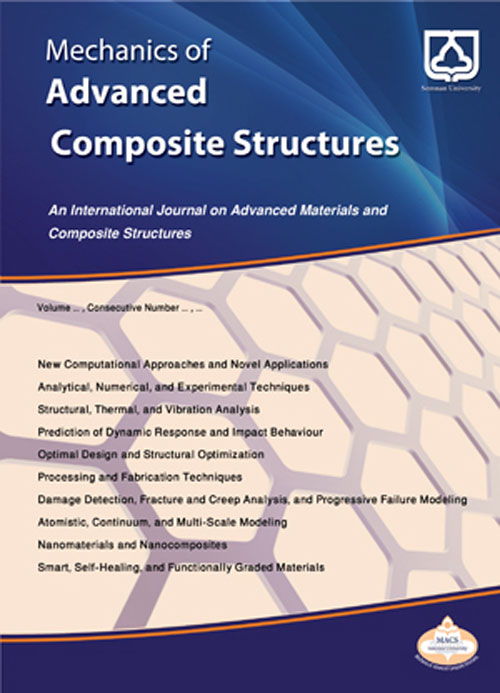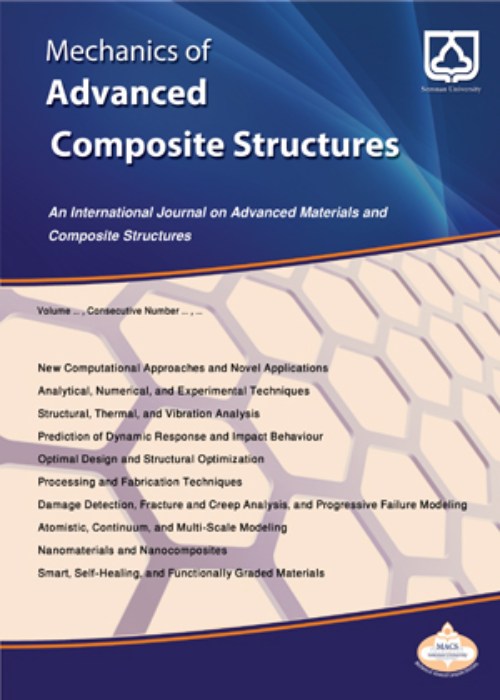فهرست مطالب

Mechanics of Advanced Composite Structures
Volume:6 Issue: 1, Winter-Spring 2019
- تاریخ انتشار: 1398/03/21
- تعداد عناوین: 9
-
-
Pages 1-8Results of electro-thermo-elastic analysis of a functionally graded thick-walled spherical shell made of temperature dependent materials are presented in this article. All material properties are assumed temperature-dependent and also are graded along the thickness direction based on power function. Temperature dependency is accounted for all material properties including, thermal, mechanical and electrical properties based on linear variation. Thermal conduction relation is solved using thermal boundary conditions at inner and outer radii for temperature dependent and independent cases. Substitution of temperature distribution into constitutive relations and then into equilibrium and Maxwell equations would give final governing equations having variable thickness. The variable coefficient governing equations are solved using the division method. The numerical results are presented for both temperature-dependent and temperature-independent cases so as to investigate the effect of temperature dependencies. The results indicate that considering temperature dependency would lead to significant changes in responses including radial and circumferential displacements and stresses, electric potential and temperature distribution.Keywords: Temperature dependent materials, Functionally graded spherical shell, Division method, Thermal conductivity, Maxwell equation
-
Pages 9-18The inconsistencies accompanied with material properties tipically cause the rise of delamination risk in composites made of different types of glass and crabon fibers. In this study, the delamination of a composite beam reinforced with a carbon layer under bending load is investigated. To this end, a small piece of a wind turbine blade root in the form of a heterogeneous laminated plate is simulated and analyzed. The methodology consists of two parallel approaches, including the experimental measurements and computer simulations. In the experimental program, the delamination of different specimens has been examined by three-point bending (3PB) tests. The diagrams of load versus load line displacement are recorded. In computer simulation, the geometry of composite laminate is re-modeled and stress analysis is performed. The results confirm that delamination loads obtained from the simulations are reliable and in good agreement with those obtained from the experimental procedures. The results of experimental measurements and computational simulations are utilized to predict the delamination failure and to optimize the lay-up sequence of the reinforced structure.Keywords: Delamination, Laminated composites, Abaqus analysis, Three-point bending test, Cohesive zone model
-
Pages 19-26Composites have been widely used in the aerospace industry. Due to the requirement of a high safety for such structures, they could be considered for health monitoring. The acoustic emission approach is one of most effective methods for identifying damages in composites. In this article, standard specimens were made from carbon fibers and the epoxy resin, with the [03/902/02]s layout. Then, samples were subjected to low-cycle cyclic loading. Besides, signals were recorded with two types of acoustic emission sensors. Obtained results indicated that by increasing the number of cycles and approaching the final lifetime of the sample, the cumulative energy of signals increased. The fracture surface of specimens was analyzed using the scanning electron microscopy. As a consequent and a general conclusion, based on obtained results, it could be claimed that both wide-band and mid-band acoustic emission sensors could be effectively utilized for detecting the defects in composite structures.Keywords: Health monitoring, Composite structure, Low-cycle cyclic loading, Acoustic emission, Sensor type
-
Pages 27-34In this study, nonlinear vibration of a composite cable is investigated by considering nonlinear stress-strain relations. The composite cable is composed of an aluminum wire as reinforcement and a rubber coating as matrix. The nonlinear governing equations of motion are derived about to an initial curve and based on the fundamentals of continuum mechanics and the nonlinear Green-Lagrangian strain, using the Hamilton's principle. The equations of motion of the system are reduced into the ordinary differential equations using the Galerkin method, and solved by the perturbation method (multiple scales). Time-response diagrams are presented for the composite cable with different volume fractions of the matrix and the reinforcement. It is predicted that the more volume fraction of the matrix is, the more nonlinear quadratic and cubic terms in the governing equations of motion affects the vibration of the cable. Results indicate that increasing the length of the cable would decrease the amplitude of the time response of the system.Keywords: Nonlinear vibration, Cable, Composite, Nonlinear strain
-
Pages 35-44In the present article, a numerical study is performed to investigate the crushing behavior of cylindrical and conical corrugated composite tubes. Different aluminum foams are applied to the proposed structures in order to offer an excellent energy absorption capacity. The crushing behavior of tubes are evaluated in terms of two parameters: SEA (specific energy absorption) and CFE (crush force efficiently). So, in order to study the effect of corrugation on the crashworthiness of composite tubes, a comprehensive numerical analysis of corrugated carbon/BMI tubes is performed under axial loadings. The effect of geometric parameters of corrugation including number and radius of corrugations is studied by FE simulation of several models in LS-DYNA. Comparison between corrugated tubes and straight one demonstrated that the CFE would be improved significantly in these new models. Furthermore, the absorbed energy increased by using foams. SEA, mean force and peak forces increased by increasing the foam density while the crush force efficiently decreased considerably due to the fact that in higher densities, densification region accrues in fewer strains.Keywords: Composite, Cylindrical, Conical Corrugated Tubes, Energy Absorption, Aluminum Foam
-
Pages 45-50Due to the mismatch of mechanical properties in composite laminates, propagation of delami-nation is considered as a severe damage mechanism in beams with various lay-up configurations. Delamination can be generated due to matrix cracking propagation or it can also be initiated due to the manufacturing process before using composite beams. Using a micromechanics model, this study is aimed to investigate the bending moment required for matrix cracking and induced delamination in cross-ply composite beams. To that end, a unit cell is selected from the lamina surface in a composite beam containing matrix cracking and delamination. Later, the governing equation of stress and displacement fields are extracted in the unit cell to calculate the strain energy release rate due to the propagation of matrix cracking and induced delamination. In order to validate this method, the stiffness variations in Carbon-Epoxy cross-ply laminate [90/02]s is examined and the obtained results are compared with the numerical results. It concluded that there is a favorable agreement between the results of the proposed micromechanics model and available numerical results.Keywords: Matrix cracking, Delamination, Micromechanics, Unit cell, Strain energy release rate
-
Pages 51-56Due to the importance effect of magnetic field on the history of long-term radial and circumfer-ential creep strain and radial displacement for a three-phase nano-composite exposed to an internal pressure and placed uniform temperature, the present article subject has been pro-posed. Three-phase nano-composite made of single-walled carbon nano tubes (SWCNTs)/ glass fiber (GF)/vinylester used to micromechanical models in order to calculate the mechanical and thermal properties. By assuming non-linear viscoelastic based on Schapery integral model and using classical laminate theory, Prandtl-Reuss relations and Mendelson’s approximation meth-od achieved results. Distribution of the radial creep strain, circumferential creep strain and radial displacement in two states including without and with magnetic field and three tempera-ture conditions for laminated lay-ups [0/45/0/45] described for 10 years. The results indicate that the magnetic field has reduced the radial and circumferential creep strain and radial dis-placement. Furthermore, the temperature increase in the magnetic field is less effective on the increased values of creep strain and radial displacement. Finally, It has been founded that mag-netic field would reduce the creep strain of all case studies.Keywords: Thermo-magneto-mechanical loading, Three-phase composite cylinder, Micromechanical model
-
Pages 57-64In this article, the results of a study on energy absorption characteristics of foam-filled thin-walled structures with finite element analysis have been presented. Four specimens of thin walled structures have been filled with uniform foam and three specimens have been filled with linear four-layered foam. Also, eight layers HLH (High-Low-High) and eight layers LHL (Low-High-Low) have been simulated. The total weight of all layered specimens is the same and main difference is just the arrangement of the layers. In order to study the energy absorption behavior of the specimens, they have been subjected to quasi-static crushing load. The results indicated that by utilizing the filler foam in the thin-walled energy absorbers, the energy absorption capacity of the foam filled specimens in comparison with hollow specimens, significantly promotes; however, the initial peak force for hollow specimens is lower than the foam-filled specimens. Consequently, from the layered specimens, LHL showed higher specific energy absorption and less initial peak force compared with other specimens, in which the LHL specimen shows 16% more initial peak force and 114% more specific energy absorption than the hollow specimen.Keywords: Energy absorption, Thin-walled tube, Graded layered foam, Crashworthiness, Polyurthane
-
Pages 65-74In this study, nonlinear bending of functionally graded (FG) circular sector plates with simply supported radial edges subjected to transverse mechanical loading has been investigated. Based on the first-order shear deformation plate theory with von Karman strain-displacement relations, the nonlinear equilibrium equations of sector plates are obtained. Introducing a stress function and a potential function, the governing equations which are five non-linear coupled equations with total order of ten are reformulated into three uncoupled ones including one linear edge-zone equation and two nonlinear interior equations with total order of ten. The uncoupling makes it possible to present analytical solution for nonlinear behavior of FG sector plates with simply-supported radial edges via perturbation technique and Fourier series method. The material properties are graded through the plate thickness according to a power-law distribution of the volume fraction of the constituents. The results are verified by comparison with the existing ones in the literature. The effects of non-linearity, material constant and boundary conditions on bending of an FG sector plate are studied. It is shown that in bending analysis of functionally graded sector plates, linear theory is solely applicable for w/h and is inadequate for analysis of fully simply supported FG sector plates even in the small deflection range.Keywords: Functionally graded materials, First-order shear deformation plate theory, Sectorial plate, Nonlinear analysis, Perturbation technique


